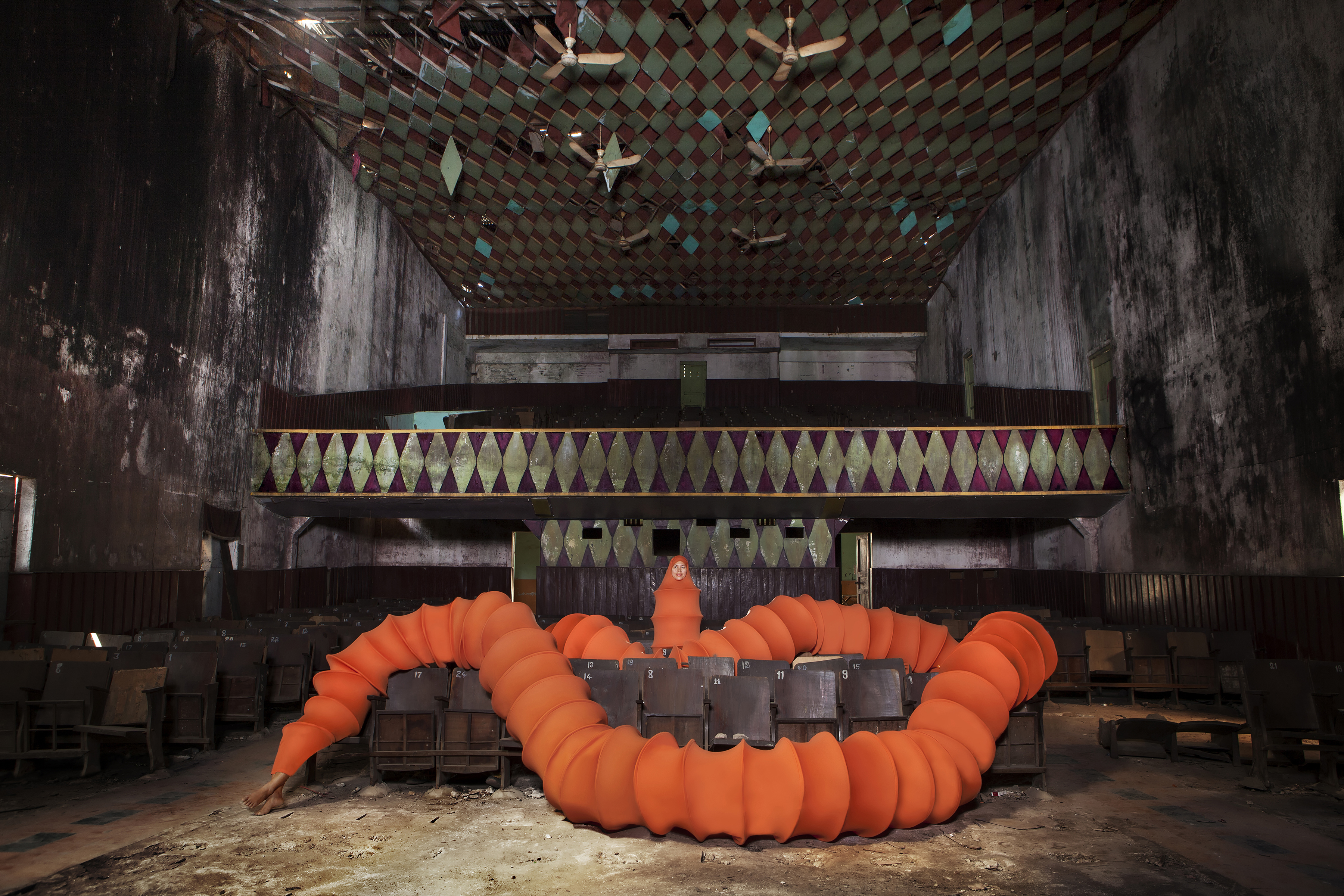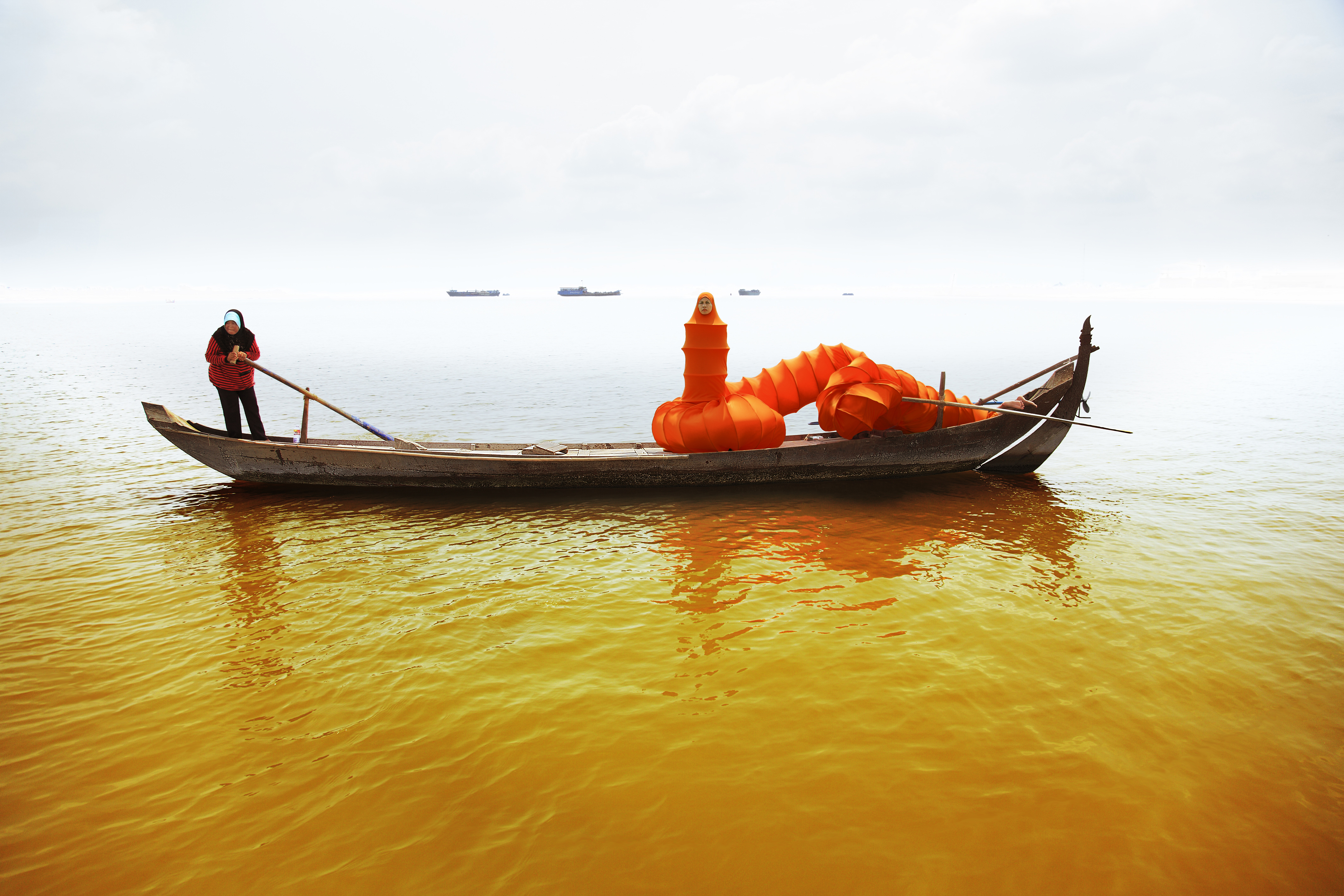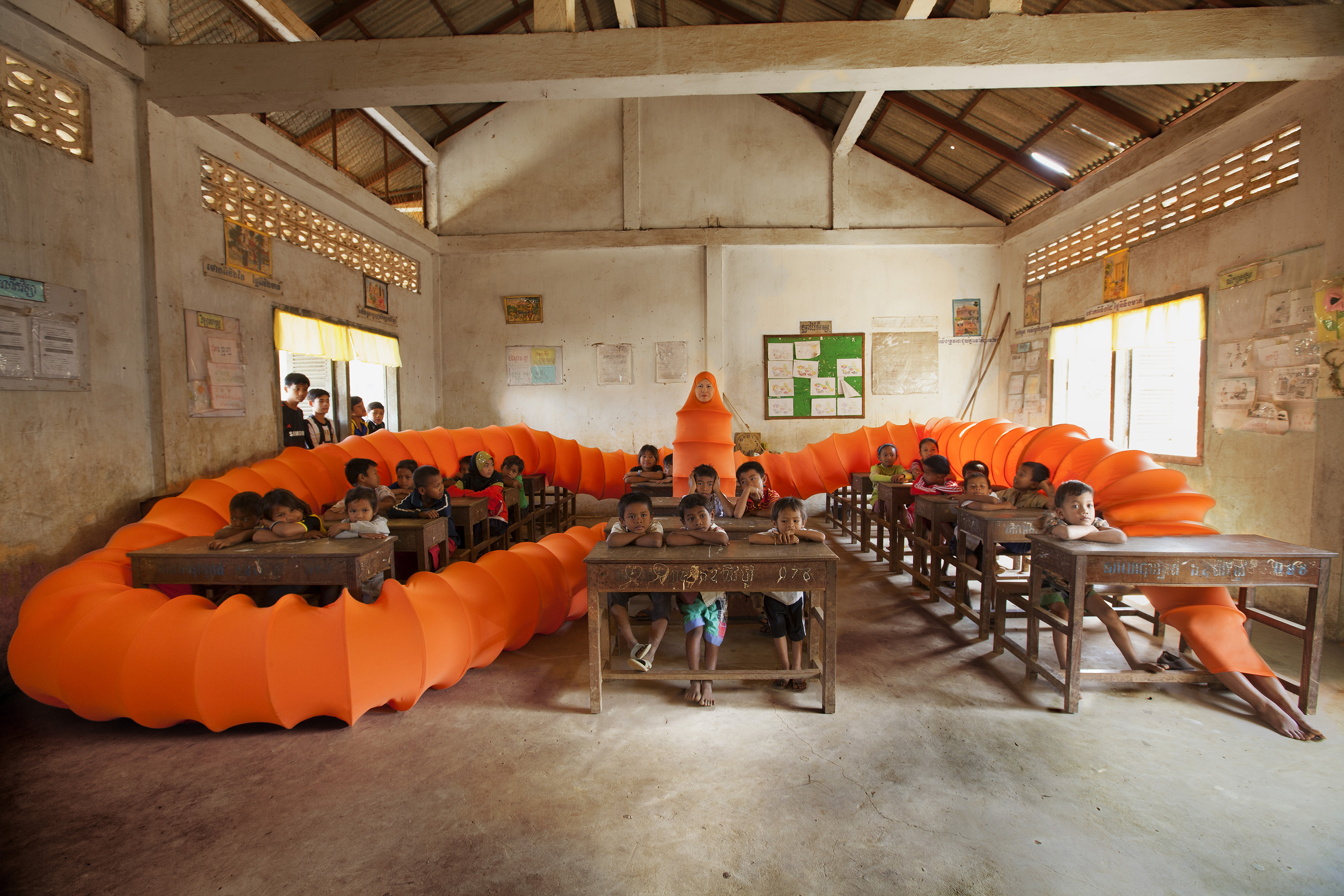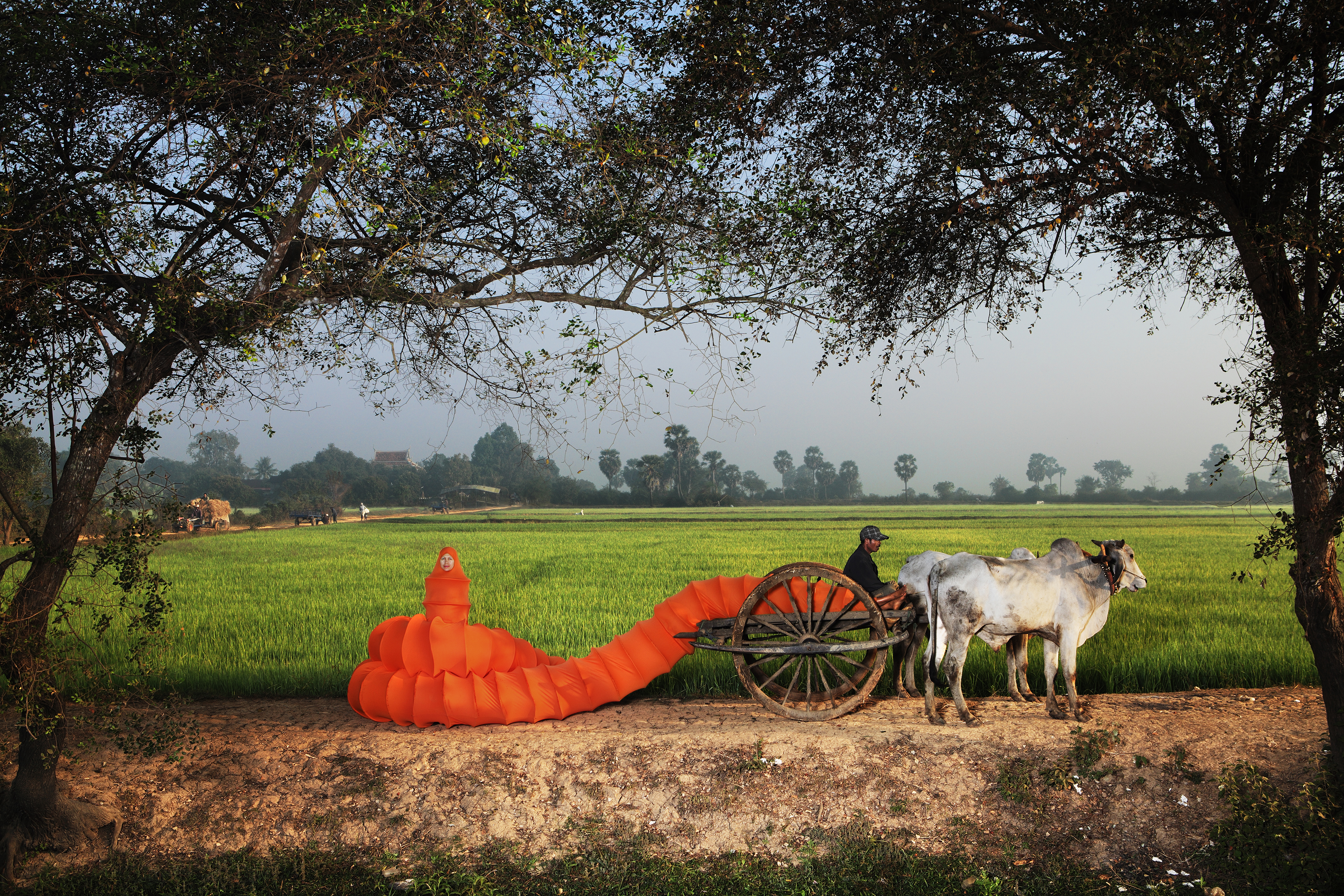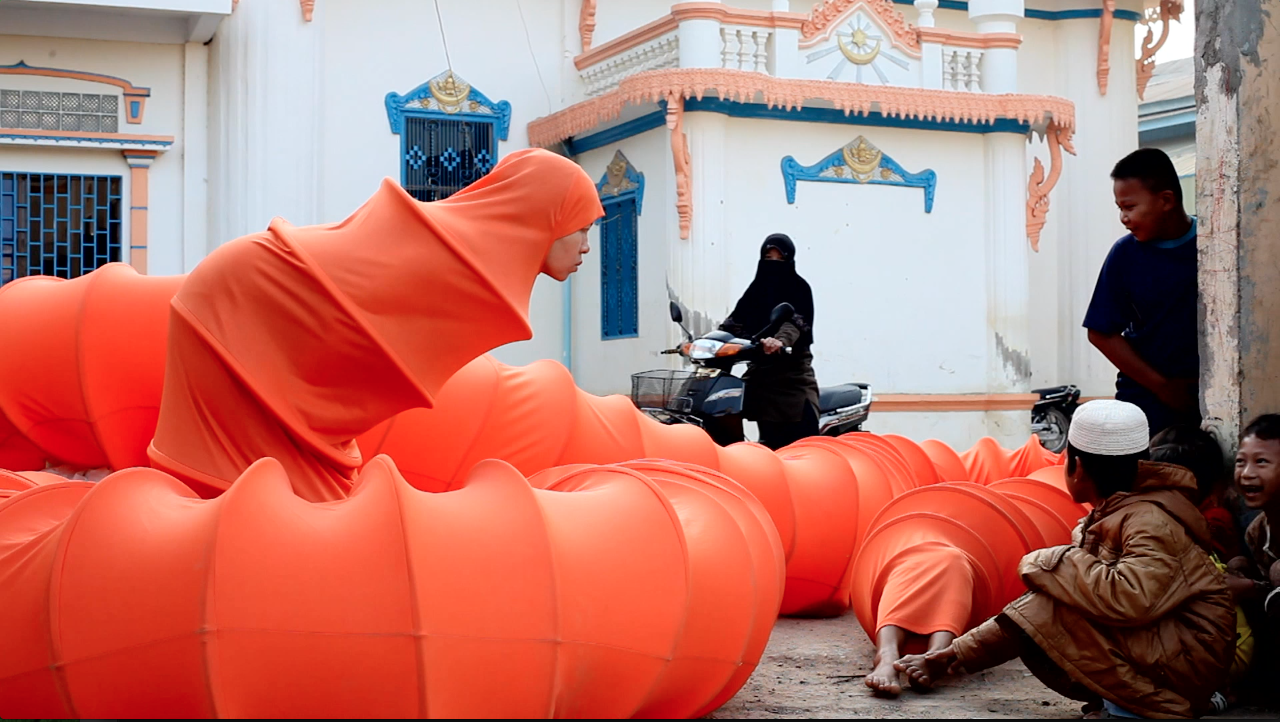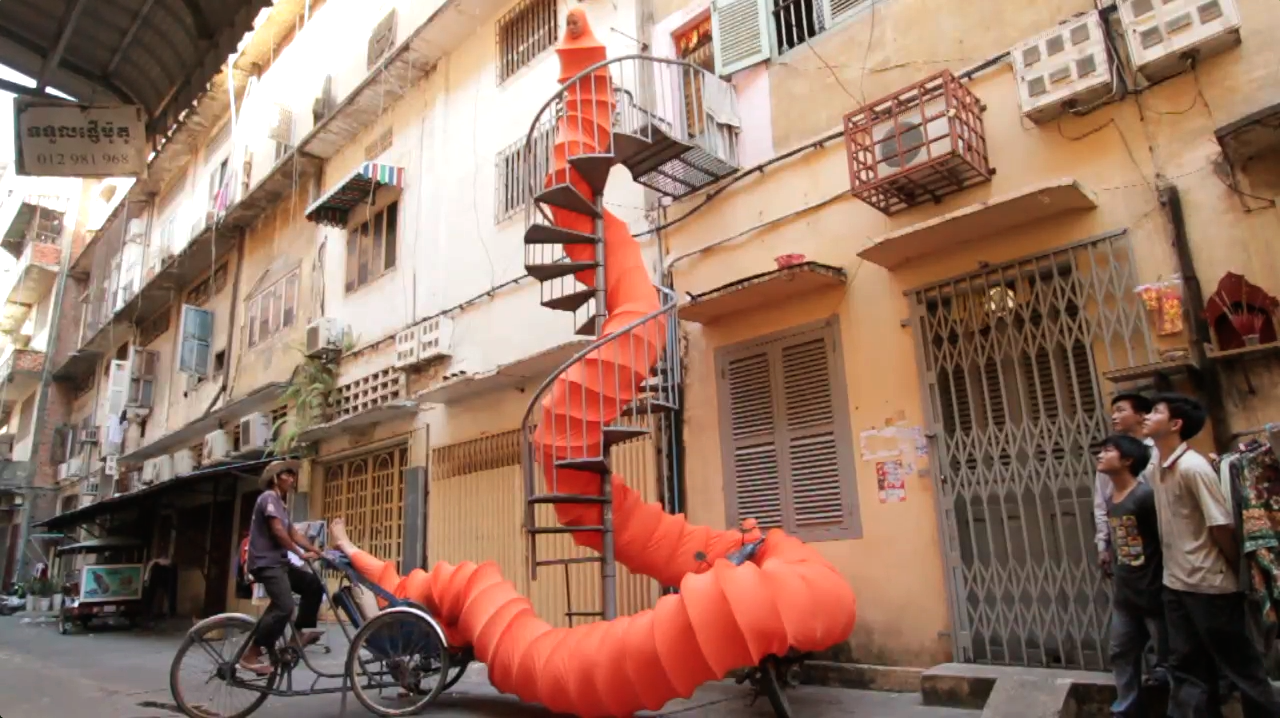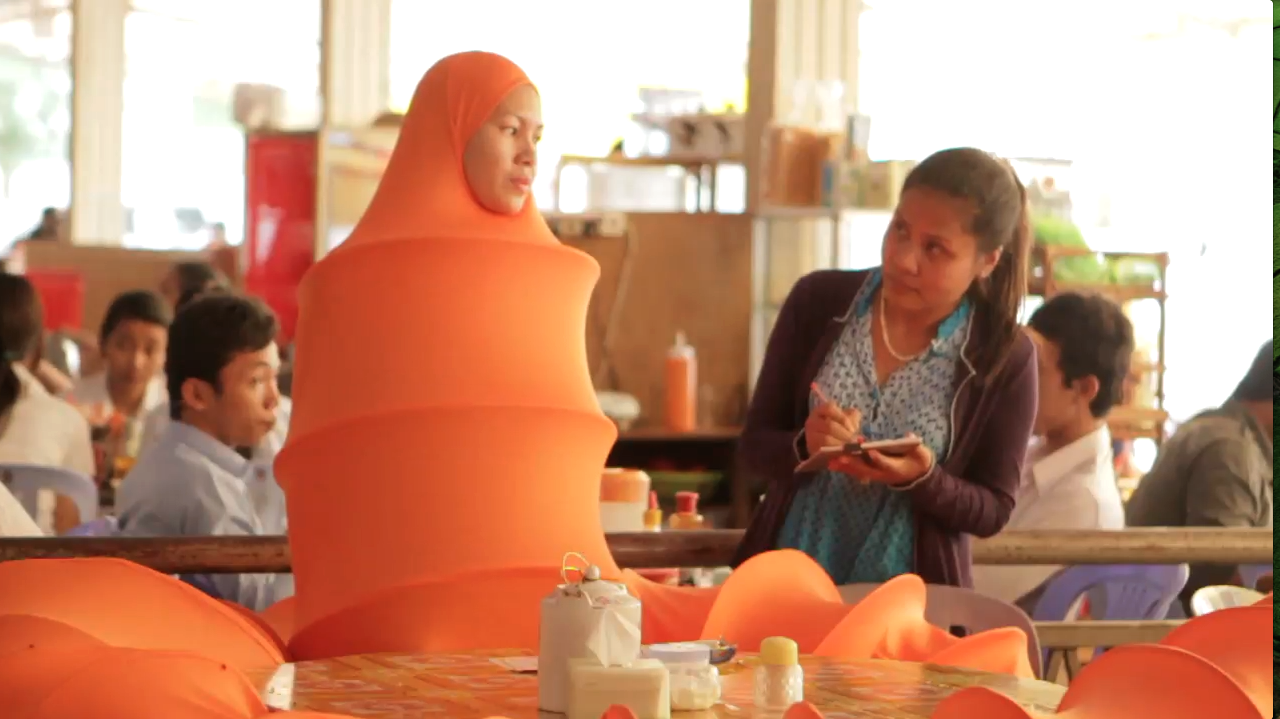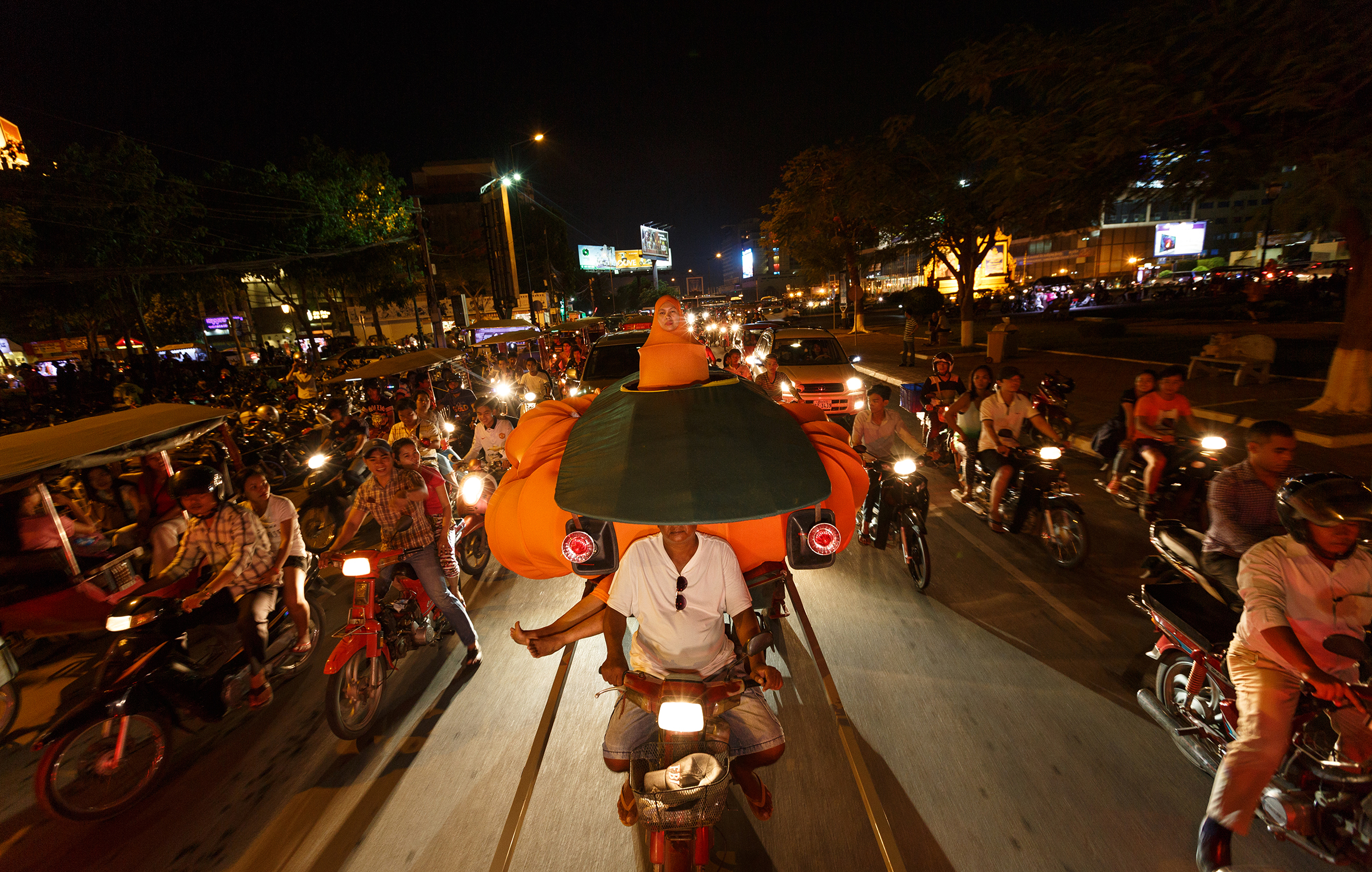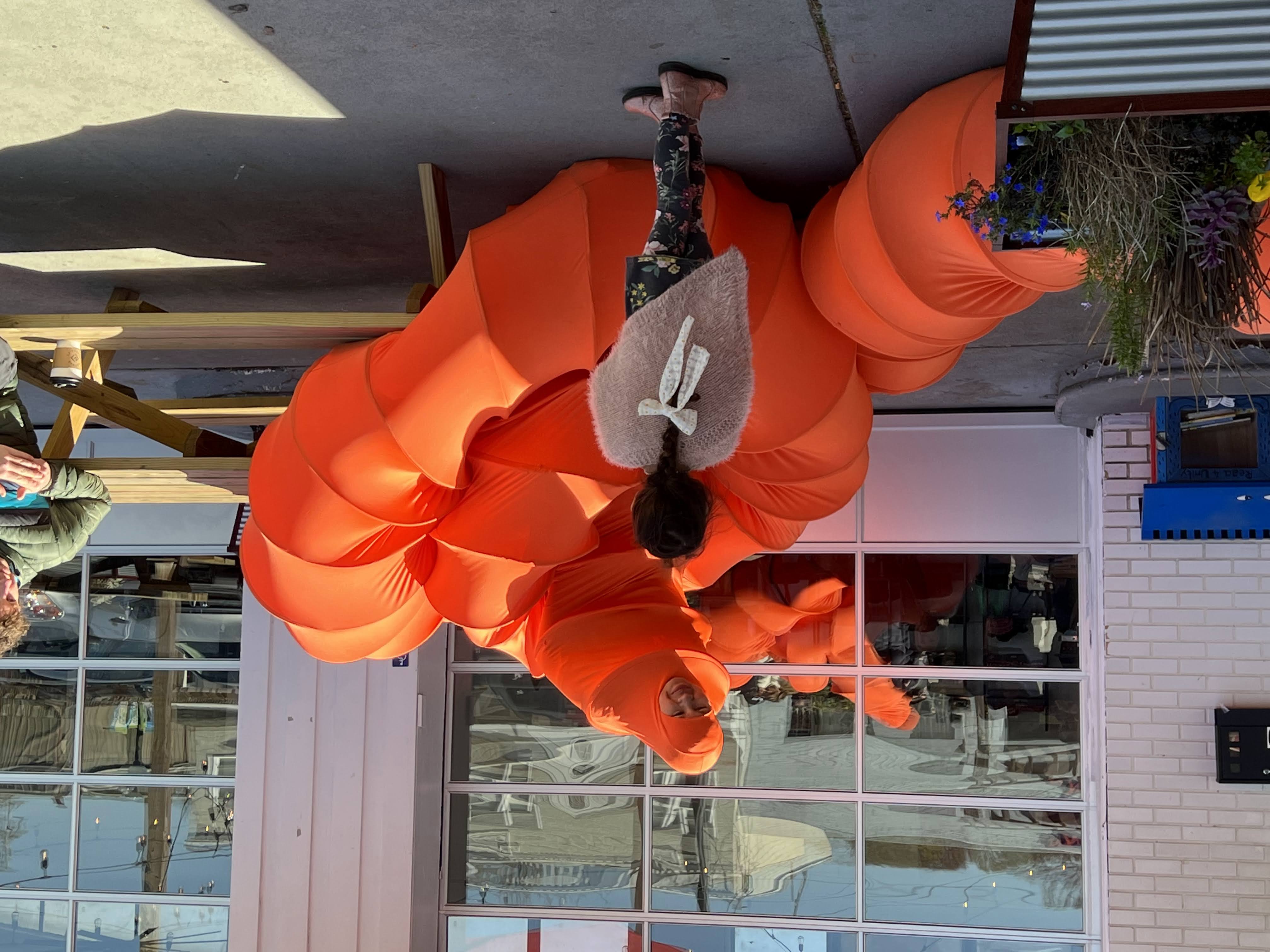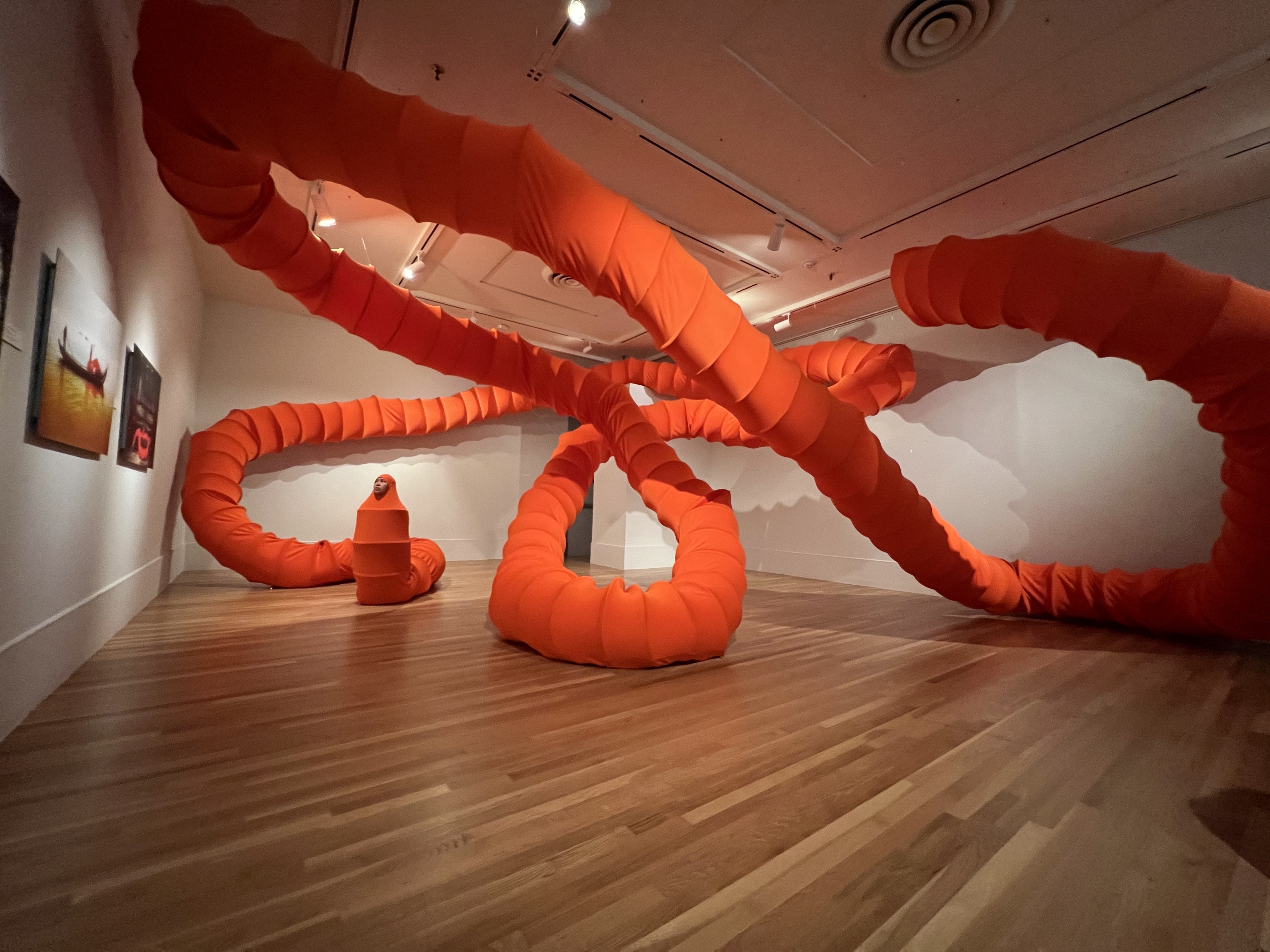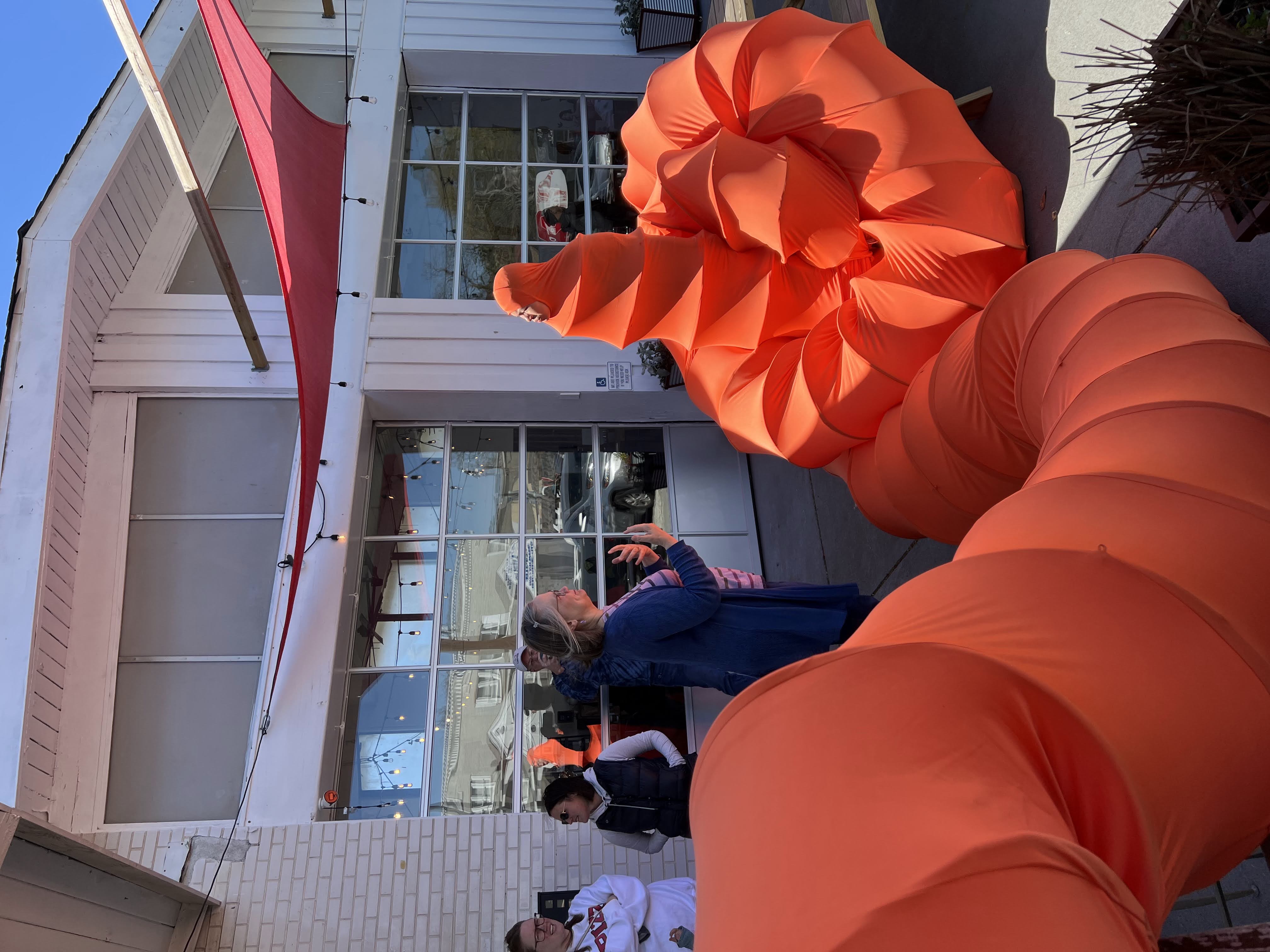Anida Yoeu Ali (Cambodian American, b. 1974)
They make their way up the spiral staircase toward home. They are sure this is their home, their body perfectly formed to the caracol, though they haven’t been there for so long. A crowd starts to form and stares at the stranger. They are as curious as they are a curiosity. In Spiral Alley, The Buddhist Bug, by their very nature, stands out, blends in, and “provokes obvious questions of belonging and displacement.”1 The power of the Bug is their ability to stretch up to one hundred meters of saffron polyester-Lycra skin, making it impossible to overlook their invasion of personal space. But the Bug also conforms to the landscape and architecture around them, tucked in and unable to distinguish themselves from the environment.
The Bug’s artist, Anida Yoeu Ali, fled Battambang, Cambodia, with her family to escape the terror of the Khmer Rouge. The town was predominantly Muslim and Ali was just five years old, an age at which you hear the whispers of your parents, the snippets on the news, and you see the acts of destruction. You know what the words mean, but you don’t understand their depth. Perhaps what the Bug teaches, as they struggle to fit in as they conform to the space they occupy, is that regardless of our age, we can never truly understand the act of destruction, displacement from community, or governmental corruption.
The migration of people and communities—through displacement or in search of opportunity—and the shifts in cultural and national identity that go with it have been well-documented as a scholarly discourse on globalization has developed. Arjun Appadurai’s seminal 1996 book Modernity at Large shifted the conversation to suggest that from the mid-1970s (around the time Ali’s family was exiled), a new dimension of globalization occurred in which long-distance nationalism created new decentralized “scapes,” which serve as the foundation for imagined worlds or “the multiple worlds that are constituted by the historically situated imaginations of persons and groups spread around the globe.”2 When Appadurai was writing twenty-five years ago, he was moved by the pace of exchange, which has only picked up in speed and efficiency. The Bug, as Ali explains “is a displaced creature destined to travel and wander amidst the ‘in-between.’” The space, which exists between who s/he is and where s/he is, is in fact a powerful place for encounter, habitation and reinvention.”3 This raises the question, does the pace of change within our decentralized world create even bigger chasms of the in-between? The root of the Bug’s displacement is trauma, embedded deep within their experience. The Bug often finds themselves contorted within a space that exists for all immigrants, “one that is caught between memory and reinvention.”4 The Bug explores this sense of otherness with humor, and should you see the Bug interact with children, there is a sense of inquisitiveness and play. The interactions between the Bug and those around them point to the fact that we are all beginning to live in the “in-between.”
This in-between is not just the sense of otherness one feels when they have emigrated to a new country and culture; it also speaks to the otherness that can occur within one’s country, highlighted in Cambodia by the conflict between a Muslim minority and Buddhist majority. Ali alludes to the enduring internal and external conflict between Buddhism and Islam. The saffron-colored Bug references the orange robes worn by Buddhist monks signifying their pledge of devotion to their order and to simplicity. Under the Khmer Rouge, religion was suppressed and they created antireligious policies, while at the same time executing Muslims across the country along with educators and alleged political and ideological opponents, resulting in the genocide of between one million and three-and-a-half million Cambodians.5 The Bug is born of this tragedy, swallowing conflict and despair so that in performance they influence “collective healing.”6 After the fall of the Khmer Rouge, Buddhism became the official Cambodian state religion, and while the government still asserts that they support religious freedom, 95 percent of the country identifies as Theravada Buddhist while the approximately 2.1 percent of Muslims are the second-largest religious group.
Focusing on the Khmer Rouge denies the complexity of occupation in Cambodia, which the Buddhist Bug tackles in their own subtle way. Cambodia was integrated into the French Indochina colony from the mid-nineteenth century until independence in 1953. The legacy of this enterprise was certainly far-reaching, but what remains is the shell of culture, remnants of French colonial cuisine and architecture. For example, in The Old Cinema, the Bug sits in the middle of a dilapidated theater, once a chic spot representing contemporary cosmopolitanism. The jarring visual contrasts expose all kinds of contradictions, and Ali insists that “the Bug is an assertion of paradoxes, a result of a hybrid refugee experience, embodying the fluctuating inside/outside perspective of the transnational being. S/he longs for stillness while on a constant journey. S/he is a source for refuge while on a perpetual search for home. S/he is both a bridge and obstacle. S/he is a creature belonging in this world yet appearing to be from another universe.”7
The Bug, when seen in a photograph, on film, or even in the gallery, is only a partial art form. The Bug is activated through performance in the community, engaging with others—strangers. Like the winged creature Malaïka Dotou Sankofa, the Bug has a hybrid form, a wormlike inching creature, visually insectoid, brought to life by human performers inside. Ali’s lived experience shows the connection among corruption, human rights violations, and subsequent displacement, but the resulting work of art, unnatural in form, shows that it is possible to take ownership over monsters, and that they can be used to examine our humanity and create a path to heal.
Notes
-
Anida Yoeu Ali, The Buddhist Bug: A Creation Mythology (Kuala Lumpur: Wei-Ling Contemporary, 2019), 5. ↩︎
-
Arjun Appadurai, Modernity at Large: Cultural Dimensions of Globalization (Minneapolis: University of Minnesota Press, 1996), 33. ↩︎
-
Ali, The Buddhist Bug, 5. ↩︎
-
Anida Yoeu Ali, “The Buddhist Bug: My Creation Mythology,” Visual Anthropology 31 (2018): 150. See also Ali, The Buddhist Bug, 5. ↩︎
-
Office of International Religious Freedom, 2020 Report of International Religious Freedom: Cambodia, May 12, 2021, https://www.state.gov/reports/2020-report-on-international-religious-freedom/cambodia. ↩︎
-
Ali, The Buddhist Bug, 6. ↩︎
-
Ali, “The Buddhist Bug: My Creation Mythology,” 150. See also Ali, The Buddhist Bug, 5. ↩︎
